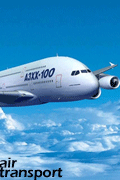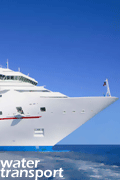Monday, May 11, 2009
The seven largest network airlines, as a group, reported an operating loss margin of 6.7 percent in the fourth quarter of 2008, the fifth consecutive quarterly loss margin since the group reported a profit margin in the third quarter of 2007, the Bureau of Transportation Statistics (BTS) of the U.S. Department of Transportation reported today in a release of preliminary data.
BTS, a part of the Research and Innovative Technology Administration, reported that six of the seven reporting network airlines, most of the industry's largest carriers, reported an operating loss margin in the October-to-December period. Only Alaska Airlines reported an operating profit.
The low-cost and regional airlines groups both reported operating profit margins for the fourth quarter. Only low-cost Virgin America and regional ExpressJet Airlines reported loss margins. Virgin America with fourth quarter revenue exceeding $100 million is included in this release for the first time this quarter.
Operating margin measures profit or loss as a percentage of the airline's total operating revenue.The seven network airlines spent 30.2 percent of their operating expenses in the fourth quarter of 2008 on fuel, compared to 13.5 percent five years earlier in the fourth quarter of 2003.
The total industry collected $498.6 million in excess baggage fees in the fourth quarter of 2008, up 42 percent from the $350.1 million collected in the third quarter and up 301 percent from the $124.2 million collected in the fourth quarter of 2007. Passenger revenue for the 21 airlines in this press release declined $4.2 billion from the third quarter to fourth quarter in 2008.
Operating Margins
The seven network carriers posted a loss margin of -6.7 percent in the fourth quarter with a combined operating loss of $1.684 billion. In the fourth quarter of 2007, the seven network carriers reported an operating loss margin of -1.1 percent with a combined loss of $274 million.
The top three operating profit margins were reported by low-cost carriers Allegiant, Spirit and AirTran Airlines. Low-cost carrier Virgin America and network carriers Northwest Airlines and United Airlines reported the largest operating loss margins.
Network carriers operate a significant portion of their flights using at least one hub where connections are made for flights on a spoke system. Low-cost carriers are those that the industry recognizes as operating under a low-cost business model, with lower infrastructure and aircraft operating costs. Regional carriers provide service from small cities, using primarily regional jets to support the network carriers' hub and spoke systems. The selected groups consist of those airlines in each group with the highest reported operating revenue in the most recent 12-month period.
Fuel Expenses
The seven reporting network carriers spent 4.89 cents per available seat-mile (ASM) for fuel in the fourth quarter of 2008, down from 6.20 cents per ASM in the third quarter.
Network airlines Northwest and United and regional carrier American Eagle Airlines spent the most for fuel per ASM while regional carriers ExpressJet and SkyWest Airlines and low-cost carrier Virgin America spent the least.
Low-cost airlines Allegiant Air and JetBlue Airways and network airline Northwest spent the largest portion of their operating costs for fuel while regionals ExpressJet and Horizon Air and network carrier US Airways spent the least.
Unit Costs
The seven network carriers reported unit costs of 16.2 cents per ASM in the fourth quarter of 2008 up from 14.5 cents per ASM in the fourth quarter of 2007.The carriers with the highest unit costs were regional airlines Comair and Horizon and network airline Northwest. The lowest unit costs were reported by regional carrier ExpressJet and low-cost carriers Allegiant and Spirit.
Unit Revenues
The seven network carriers' unit revenues in the fourth quarter of 2008 were 15.2 cents per ASM compared to 14.4 cents in the fourth quarter of 2007.
The highest unit revenues were reported by regional carriers Comair, Horizon and American Eagle. The lowest unit revenues were reported by regional carrier ExpressJet and low-cost carriers Spirit and Virgin America. US Airways reported the highest unit revenues of any network airline
Passenger Yield
The seven network airlines' passenger yield was 13.3 cents per revenue passenger-mile (RPM) in the fourth quarter of 2008, up from 12.9 cents per RPM in the fourth quarter of 2007. The fourth quarter of 2008 marked the first time since BTS began reporting yield statistics in the second quarter of 2002 that the network airlines' passenger yield fell below that of the low-ost carriers. Passenger revenue yield measures passenger revenues against total travel by dividing passenger revenues by RPMs.
The top passenger revenue yields were reported by regional carriers Comair, Horizon and American Eagle. The lowest passenger revenue yields were reported by regional carrier ExpressJet and low-cost carriers Allegiant and Spirit. Continental Airlines reported the highest passenger yield of any network carrier.
BTS, a part of the Research and Innovative Technology Administration, reported that six of the seven reporting network airlines, most of the industry's largest carriers, reported an operating loss margin in the October-to-December period. Only Alaska Airlines reported an operating profit.
The low-cost and regional airlines groups both reported operating profit margins for the fourth quarter. Only low-cost Virgin America and regional ExpressJet Airlines reported loss margins. Virgin America with fourth quarter revenue exceeding $100 million is included in this release for the first time this quarter.
Operating margin measures profit or loss as a percentage of the airline's total operating revenue.The seven network airlines spent 30.2 percent of their operating expenses in the fourth quarter of 2008 on fuel, compared to 13.5 percent five years earlier in the fourth quarter of 2003.
The total industry collected $498.6 million in excess baggage fees in the fourth quarter of 2008, up 42 percent from the $350.1 million collected in the third quarter and up 301 percent from the $124.2 million collected in the fourth quarter of 2007. Passenger revenue for the 21 airlines in this press release declined $4.2 billion from the third quarter to fourth quarter in 2008.
Operating Margins
The seven network carriers posted a loss margin of -6.7 percent in the fourth quarter with a combined operating loss of $1.684 billion. In the fourth quarter of 2007, the seven network carriers reported an operating loss margin of -1.1 percent with a combined loss of $274 million.
The top three operating profit margins were reported by low-cost carriers Allegiant, Spirit and AirTran Airlines. Low-cost carrier Virgin America and network carriers Northwest Airlines and United Airlines reported the largest operating loss margins.
Network carriers operate a significant portion of their flights using at least one hub where connections are made for flights on a spoke system. Low-cost carriers are those that the industry recognizes as operating under a low-cost business model, with lower infrastructure and aircraft operating costs. Regional carriers provide service from small cities, using primarily regional jets to support the network carriers' hub and spoke systems. The selected groups consist of those airlines in each group with the highest reported operating revenue in the most recent 12-month period.
Fuel Expenses
The seven reporting network carriers spent 4.89 cents per available seat-mile (ASM) for fuel in the fourth quarter of 2008, down from 6.20 cents per ASM in the third quarter.
Network airlines Northwest and United and regional carrier American Eagle Airlines spent the most for fuel per ASM while regional carriers ExpressJet and SkyWest Airlines and low-cost carrier Virgin America spent the least.
Low-cost airlines Allegiant Air and JetBlue Airways and network airline Northwest spent the largest portion of their operating costs for fuel while regionals ExpressJet and Horizon Air and network carrier US Airways spent the least.
Unit Costs
The seven network carriers reported unit costs of 16.2 cents per ASM in the fourth quarter of 2008 up from 14.5 cents per ASM in the fourth quarter of 2007.The carriers with the highest unit costs were regional airlines Comair and Horizon and network airline Northwest. The lowest unit costs were reported by regional carrier ExpressJet and low-cost carriers Allegiant and Spirit.
Unit Revenues
The seven network carriers' unit revenues in the fourth quarter of 2008 were 15.2 cents per ASM compared to 14.4 cents in the fourth quarter of 2007.
The highest unit revenues were reported by regional carriers Comair, Horizon and American Eagle. The lowest unit revenues were reported by regional carrier ExpressJet and low-cost carriers Spirit and Virgin America. US Airways reported the highest unit revenues of any network airline
Passenger Yield
The seven network airlines' passenger yield was 13.3 cents per revenue passenger-mile (RPM) in the fourth quarter of 2008, up from 12.9 cents per RPM in the fourth quarter of 2007. The fourth quarter of 2008 marked the first time since BTS began reporting yield statistics in the second quarter of 2002 that the network airlines' passenger yield fell below that of the low-ost carriers. Passenger revenue yield measures passenger revenues against total travel by dividing passenger revenues by RPMs.
The top passenger revenue yields were reported by regional carriers Comair, Horizon and American Eagle. The lowest passenger revenue yields were reported by regional carrier ExpressJet and low-cost carriers Allegiant and Spirit. Continental Airlines reported the highest passenger yield of any network carrier.
posted by transport blogs
@ 11:28 PM
permanent link | Post a Comment
|
![]()









